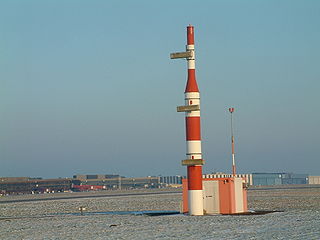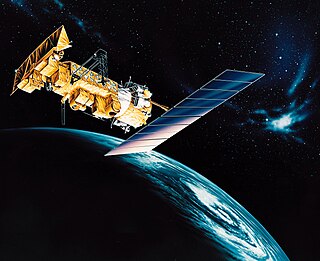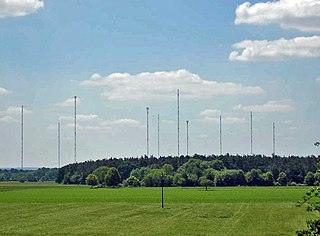Frequency allocation
The allocation of radio frequencies is provided according to Article 5 of the ITU Radio Regulations (edition 2012). [3]
In order to improve harmonisation in spectrum utilisation, the majority of service-allocations stipulated in this document were incorporated in national Tables of Frequency Allocations and Utilisations which is with-in the responsibility of the appropriate national administration. The allocation might be primary, secondary, exclusive, and shared.
- primary allocation: is indicated by writing in capital letters (see example below)
- secondary allocation: is indicated by small letters (see example below)
- exclusive or shared utilization: is within the responsibility of administrations
- Example of frequency allocation
| Allocation to services |
| Region 1 | Region 2 | Region 3 |
13.4-13.75 GHz EARTH EXPLORATION-SATELLITE (active)
- RADIOLOCATION
SPACE RESEARCH
Standard frequency and time signal-satellite (Earth-to-space)
|
14–14.25 GHz FIXED-SATELLITE (Earth-to-space)
- RADIONAVIGATION
Mobile-satellite (Earth-to-space)
Space research
|
14.25–14.3 GHz FIXED-SATELLITE (Earth-to-space)
- RADIONAVIGATION
Mobile-satellite (Earth-to-space)
Space research
|

Fixed-satellite service is – according to article 1.21 of the International Telecommunication Union's (ITU) Radio Regulations (RR) – defined as A radiocommunication service between earth stations at given positions, when one or more satellites are used; the given position may be a specified fixed point or any fixed point within specified areas; in some cases this service includes satellite-to-satellite links, which may also be operated in the inter-satellite service; the fixed-satellite service may also include feeder links for other space radiocommunication services.

Aeronautical radionavigation service is – according to Article 1.46 of the International Telecommunication Union's (ITU) Radio Regulations (RR) – defined as «A radionavigation service intended for the benefit and for the safe operation of aircraft.»
Mobile service is – in line to ITU Radio Regulations – a radiocommunication service between mobile and land stations, or between mobile stations (CV).

Meteorological aids service is – according to Article 1.50 of the International Telecommunication Union´s (ITU) Radio Regulations (RR) – defined as "A radiocommunication service used for meteorological, including hydrological, observations and exploration."

Meteorological-satellite service is – according to Article 1.52 of the International Telecommunication Union´s (ITU) Radio Regulations (RR) – defined as « An earth exploration-satellite service for meteorological purposes.»

Earth exploration-satellite service is – according to Article 1.51 of the International Telecommunication Union's (ITU) Radio Regulations (RR) – defined as:
A radiocommunication service between earth stations and one or more space stations, which may include links between space stations, in which:
This service may also include feeder links necessary for its operation.

In telecommunications, a fixed service is a radiocommunication service between specified fixed points.

Space operation service is – according to Article 1.23 of the International Telecommunication Union's (ITU) Radio Regulations (RR) – defined as «A radiocommunication service concerned exclusively with the operation of spacecraft, in particular space tracking, space telemetry and space telecommand. These functions will normally be provided within the service in which the space station is operating.»

Standard frequency and time signal service is – according to Article 1.53 of the International Telecommunication Union's (ITU) Radio Regulations (RR) – defined as «A radiocommunication service for scientific, technical and other purposes, providing the transmission of specified frequencies, time signals, or both, of stated high precision, intended for general reception.»

Land mobile-satellite service is – according to Article 1.27 of the International Telecommunication Union's (ITU) Radio Regulations (RR) – defined as «A mobile-satellite service in which mobile earth stations are located on land.»

Maritime mobile-satellite service is – according to Article 1.29 of the International Telecommunication Union's Radio Regulations (RR) – "A mobile-satellite service in which mobile earth stations are located on board ships; survival craft stations and emergency position-indicating radiobeacon stations may also participate in this service", in addition to serving as navigation systems.

Aeronautical mobile service is – according to Article 1.32 of the International Telecommunication Union's (ITU) Radio Regulations (RR) – defined as "A mobile service between aeronautical stations and aircraft stations, or between aircraft stations, in which survival craft stations may participate; emergency position-indicating radiobeacon stations may also participate in this service on designated distress and emergency frequencies."

Aeronautical mobile-satellite service is – according to Article 1.35 of the International Telecommunication Union's (ITU) Radio Regulations (RR) – defined as «A mobile-satellite service in which mobile earth stations are located on board aircraft; survival craft stations and emergency position-indicating radiobeacon stations may also participate in this service. . »

Aeronautical mobile (R) service is – according to Article 1.33 of the International Telecommunication Union's (ITU) Radio Regulations (RR) – defined as «An aeronautical mobile service reserved for communications relating to safety and regularity of flight, primarily along national or international civil air routes.»

Aeronautical mobile (OR) service is – according to Article 1.34 of the International Telecommunication Union's (ITU) Radio Regulations (RR) – defined as «An aeronautical mobile service intended for communications, including those relating to flight coordination, primarily outside national or international civil air routes.»

Aeronautical mobile-satellite (R)° service is – according to Article 1.36 of the International Telecommunication Union's (ITU) Radio Regulations (RR) – defined as «An aeronautical mobile-satellite service reserved for communications relating to safety and regularity of flights, primarily along national or international civil air routes.»

Aeronautical mobile-satellite (OR)°° service is – according to Article 1.37 of the International Telecommunication Union's (ITU) Radio Regulations (RR) – defined as «An aeronautical mobile-satellite service reserved for communications relating to safety and regularity of flights, primarily outside national or international civil air routes.»
Radiodetermination-satellite service is – according to Article 1.41 of the International Telecommunication Union's (ITU) Radio Regulations (RR) – defined as «A radiocommunication service for the purpose of radiodetermination involving the use of one or more space stations. This service may also include feeder links necessary for its own operation.»

Standard frequency and time signal-satellite service is, according to Article 1.54 of the International Telecommunication Union's (ITU) Radio Regulations (RR), defined as A radiocommunication service using space stations on earth satellites for the same purposes as those of the standard frequency and time signal service.

Radiolocation-satellite service is – according to Article 1.49 of the International Telecommunication Union´s (ITU) Radio Regulations (RR) – defined as «A radiodetermination-satellite service used for the purpose of radiolocation. This (radiocommunication) service may also include the feeder links necessary for its operation.»
This page is based on this
Wikipedia article Text is available under the
CC BY-SA 4.0 license; additional terms may apply.
Images, videos and audio are available under their respective licenses.















